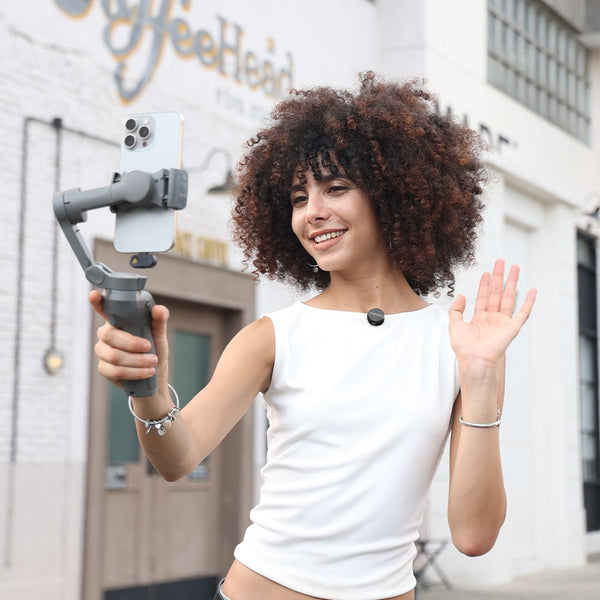Did you know that a USB condenser microphone can also be used in healthcare settings? How can this type of microphone be a good choice? Keep reading.
In today's rapidly evolving healthcare landscape, telehealth and remote consultations have become a mainstay for doctors, nurses, therapists, and other medical professionals. Whether conducting a virtual diagnosis or following up with a patient, clear and reliable audio is essential. Many healthcare providers — especially those less familiar with technology — wonder: Are USB microphones easy to set up and use?
The answer is a resounding yes. A condenser microphone with USB connectivity offers excellent sound quality, simple plug-and-play functionality, and compatibility with popular platforms like Zoom, Microsoft Teams, and Google Meet. They’re a smart, cost-effective choice for healthcare workers who need to sound professional and be heard clearly during patient interactions — without spending hours on setup or learning complex tech.

Why a USB Condenser Microphone Is a Valuable Tool for Healthcare Professionals
Condenser microphones are well known for their sensitivity and vocal clarity, making them ideal for capturing the nuances of a speaker’s voice in teleconsultation scenarios. A USB condenser microphone combines this audio quality with simple connectivity—just plug it into a computer, and you're ready to go. No need for audio interfaces, phantom power, or complex installation.
In clinical or home-office settings, where time is of the essence, the convenience of a microphone USB PC setup allows healthcare professionals to focus on patient care rather than troubleshooting tech issues. With features like built-in pop filters, cardioid condenser microphone patterns to reduce background noise, and adjustable gain controls, USB mics deliver performance without complexity. For any healthcare provider who prioritizes audio quality and ease of use, a pro condenser microphone is a smart, reliable choice.
FAQs in the Healthcare Context
1. How Do I Make My Voice Sound Clearer During Virtual Consultations?
To achieve clear, professional audio, position the mic 6–12 inches from your mouth. Choose a cardioid condenser microphone to reduce background noise. Speak naturally, avoid echoey rooms, and use built-in filters or foam windscreens to eliminate harsh consonants or popping sounds.
2. Can a USB Microphone Reduce Background Noise in a Clinic?
Yes — many USB condenser microphones feature cardioid polar patterns, which focus on capturing sound directly in front of the mic while rejecting noise from the sides and rear. This is especially useful in busy clinics where ambient noise is common. Some models also come with built-in noise reduction or offer digital enhancements via companion apps.
3. What Mic Settings Should I Use in Zoom for Better Patient Communication?
For optimal clarity:
-
Go to Zoom Settings > Audio
-
Set the microphone input to your USB computer microphone
-
Disable “Automatically adjust microphone volume” for manual gain control
-
Enable “Suppress background noise” (set to Auto or High)
-
Test your mic with Zoom’s audio test feature
Many USB computer microphones also feature on-device gain knobs to fine-tune input volume without entering software settings.
4. Do I Need Headphones Along with a USB Mic for Zoom Consultations?
While not mandatory, using headphones helps avoid audio feedback and echo, particularly if patients or colleagues are using loudspeakers. Even basic wired earbuds work well. Some USB microphones offer a headphone monitoring jack, allowing you to hear yourself in real time, which is helpful for adjusting speaking volume.
Top 3 Plug-and-Play USB Mics for Healthcare Professionals
If you're looking for easy-to-use, clear, and budget-conscious options, here are three highly recommended USB microphones:
1. Maono AU-A04 Condenser USB Microphone
-
Why it's great: The Maono AU-A04 or Maono A04, is one of the most affordable pro condenser microphone options on the market. It offers a wide frequency response (30Hz–16kHz) and cardioid pickup pattern, which ensures crisp voice capture while minimizing background noise.
-
Features:
-
Plug-and-play USB computer microphone connection
-
192kHz/24-bit resolution for studio-quality audio
-
Comes with a complete kit: mic arm, shock mount, pop filter, and windscreen
-
Ideal for quiet to moderately noisy environments
-
Special Note: Its sturdy build and professional accessories make it ideal for home offices or clinical teleconsultation stations.
2. Blue Snowball iCE
-
Why it's great: Compact, simple, and efficient. The Snowball iCE delivers clean voice audio with no setup hassle. It's an excellent choice for nurses and general practitioners working from home.
-
Features:
-
Plug-and-play microphone USB PC setup
-
Cardioid mode for focused voice pickup
-
Lightweight and portable
-
Best for: Users who want quality voice clarity on a budget.
3. Fifine K669B
-
Why it's great: A favorite among streamers and educators, the Fifine K669B is excellent for speech and voice applications.
-
Features:
-
Durable metal body
-
Volume control knob on mic
-
Surprisingly high clarity for its price range
-
Ideal for: Entry-level healthcare workers and educators who need reliable performance under $50.
Best USB Microphone for Telehealth Sessions on Zoom
Among the above, the Maono AU-A04 stands out as the best all-rounder for telehealth. Its balance of sound clarity, build quality, and bundled accessories offers excellent value. Designed with voice recording in mind, this USB condenser microphone allows healthcare providers to communicate clearly and confidently, even in less-than-perfect acoustic conditions.
Special notable features of the Maono A04:
-
High-resolution sampling rate (192kHz/24-bit) for clear and natural voice reproduction
-
Low self-noise design, reducing hissing or unwanted sound
-
Shock mount to minimize desk vibrations
-
Pop filter and foam windscreen to reduce plosives and breath noise
Whether you're using it for patient calls, professional webinars, or training videos, this versatile USB computer microphone performs reliably while remaining simple to use and budget-friendly.
Budget-Friendly USB Mic for Nurses Working from Home
For nurses and assistants looking for a low-cost but effective mic, the Maono A04 is a standout. It offers a strong balance between affordability and performance. While it may not include extras like a shock mount or boom arm, it produces clear, crisp audio that outperforms built-in laptop microphones by a mile. As a microphone USB PC option, it’s ideal for at-home telehealth settings.
Is It Safe and HIPAA-Compliant to Use USB Microphones in Teleconsultation?
Yes — USB microphones themselves do not handle or store patient data, so they do not pose a HIPAA violation risk. The key is ensuring that the telehealth platform you’re using (like Zoom for Healthcare, Doxy.me, or Microsoft Teams with healthcare settings) is HIPAA-compliant. Using a USB microphone enhances communication without compromising privacy or data security.
How Do I Test My USB Mic Before Starting a Remote Consultation?
Testing is easy:
-
Plug in the mic and select it in your audio settings.
-
Open Zoom or your telehealth platform.
-
Use the built-in “Test Mic” or “Audio Settings” feature.
-
Speak normally and listen to the playback to check clarity.
-
Adjust gain or volume directly on the mic if needed.
Some models, like the Maono A04, come with LED indicators or monitoring ports to assist with audio levels.
Do USB Microphones Work with Tablets or Mobile Phones via Zoom?
Most USB mics are designed for computers, but many can work with tablets and smartphones using OTG (On-The-Go) adapters:
-
For Android: USB-C to USB-A OTG adapter
-
For iPhone/iPad: Lightning to USB Camera Adapter
Note: Check whether the microphone supports USB class-compliant audio, which is typically plug-and-play with mobile devices. Some advanced models may require additional power or may not be recognized by older devices.

Conclusion
In the healthcare industry and virtual care, audio clarity isn't just a luxury — it's a necessity. Whether you're a physician guiding a diagnosis, a nurse following up on a treatment plan, or a therapist conducting a remote session, being heard clearly and without distractions directly affects communication quality and patient trust.
A USB condenser microphone offers the perfect blend of ease of use, affordability, and professional sound. The Maono A04 (AU-A04), Blue Snowball iCE, and Fifine K669B prove that high-quality tools don’t have to be expensive or complicated.
Equipping yourself with the right USB computer microphone — whether you're on a microphone USB PC setup or connecting via mobile — you're not just enhancing your audio, you're elevating the overall standard of care in a virtual world.
Related Article:
Streaming Medical Advice: USB Mic Tips for Doctors Going Live



